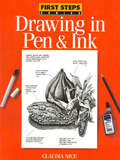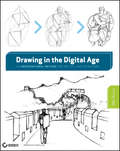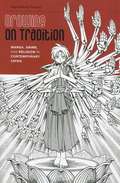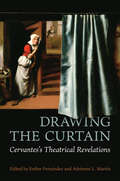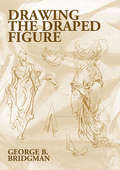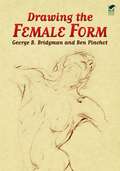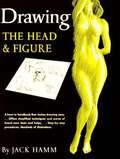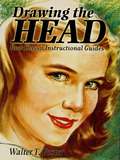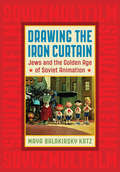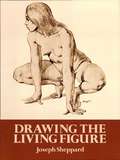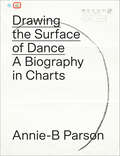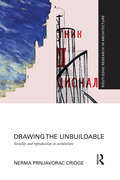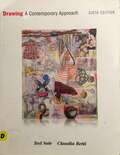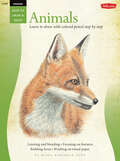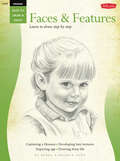- Table View
- List View
Drawing in Pen & Ink (First Steps)
by Claudia NiceGot a yearning to pick up a pen and see what you can do? Go for it! But don't sketch alone—let popular artist and teacher Claudia Nice be your guide. She'll make your first steps fun and successful! In her trademark style—friendly and encouraging—Claudia will show you how to do a sketch of a subject that actually ends up looking like the subject. And she shares her secrets for turning simple lines and dots into all kinds of lifelike textures, including leaves, glass, hair, fruit, water, clouds, wood grain, grass, fur and feathers. Easy (and fun!) exercises get you started. Step-by-step projects teach techniques as you draw trees, flowers, barns, animals and other subjects—even people! And demonstrations show you how to put all that you've learned together to create a finished picture. So go ahead—grab that pen and have fun! Just follow along with Claudia to get the hang of it, and before you know it you'll be making your own, original pen-and-ink drawings!
Drawing in the Digital Age
by Wei XuA solid foundation for improving your drawing skillsTeaching a new observational method based on math and computer graphics principles, this book offers an innovative approach that shows you how to use both sides of your brain to make drawing easier and more accurate. Author Wei Xu, PhD, walks you through his method, which consists of scientific theories and principles to deliver real-world techniques that will improve your drawing skills. Xu's pioneering approach offers a solid foundation for both traditional and CG artists. Encourages you to use both sides of your brain for drawing with the highest efficiency possibleIntroduces an innovative method invented by the author for improving your drawing skillsIf you are eager to learn how to draw, then this book is a must read.
Drawing in the Present Tense
by Claire Gilman Roger MalbertA richly illustrated, up-to-the-minute overview of new approaches in drawing, in the context of recent developments of other forms of contemporary art. Drawing in the Present Tense explores the variety of ways in which contemporary artists from around the world have come to approach drawing as the primary element of their practice. One which is autonomous: an end in itself, rather than a means to an end in another, more substantial medium. In an era of advanced technologies where image production has accelerated—potentially beyond the capacity of human attention—what values can be attributed to the slow, deliberate process of drawing by hand? The artworks featured in this volume are not confined to traditional tools; one can also draw on a computer, tablet, or smartphone, and examples of this are incorporated into the narrative as one mediumamong many. Sections are grouped thematically by specific approaches, including abstraction and figuration, nature and artifice, social observation and critique. With essays and spreads for each section, the book’s selection of seventy contemporary international artists of diverse backgrounds and experience includes not only recognizable names such as Michael Armitage, Camille Henrot, Robert Longo, Amy Sillman, and Kara Walker, but also a host of emerging talents. Beautifully presented in a visually appealing and tactile format with the feel of an artist’s portfolio, this is an inspiring overview of the best drawing practice today.
Drawing of the Hand (Dover Art Instruction)
by Joseph M. HenningerAccording to expert instructor Joseph M. Henninger, the hand is not difficult to draw when its construction is well understood. In this guide for intermediate and advanced art students, Henninger devotes the first section to the anatomy of the hand and forearm. He also shares basic but seldom observed facts concerning comparative measurements. A helpful glossary provides Latin terms, English translations, and descriptions of the hand muscles' functions.Drawings of the hand constitute the major portion of this volume, consisting mostly of adult male and female hands, followed by children's and babies' hands. The final section comprises a portfolio of drawings by Old Masters and contemporary artists, many accompanied by the author's insightful comments.
Drawing on The Dominant Eye: Decoding the Way We Perceive, Create, and Learn
by Betty EdwardsA fascinating follow-up to the beloved bestseller Drawing on the Right Side of the Brain--with new insights about creativity and our unique way of seeing the world around usMillions of readers have embraced art teacher Betty Edwards's Drawing on the Right Side of the Brain, from art students and teachers to established artists, corporate trainers, and more--all discovering a bold new way of drawing and problem-solving based on what we see, not what we think we see. In this highly anticipated follow-up, Edwards illuminates another piece of the creativity puzzle, revealing the role our dominant eye plays in how we perceive, create, and are seen by those around us. Research shows that much like being right-handed or left-handed, each of us has a dominant eye, corresponding to the dominant side of our brain--either verbal or perceptual. Once you learn the difference and try your hand at the simple drawing exercises, you'll gain fresh insights into how you perceive, think, and create. You'll learn how to not just look but truly see.Generously illustrated with visual examples, this remarkable guided tour through art history, psychology, and the creative process is a must-read for anyone looking for a richer understanding of our art, our minds, and ourselves.
Drawing on Tradition: Manga, Anime, and Religion in Contemporary Japan
by Jolyon Baraka ThomasManga and anime (illustrated serial novels and animated films) are highly influential Japanese entertainment media that boast tremendous domestic consumption as well as worldwide distribution and an international audience. Drawing on Tradition examines religious aspects of the culture of manga and anime production and consumption through a methodological synthesis of narrative and visual analysis, history, and ethnography. Rather than merely describing the incidence of religions such as Buddhism or Shinto in these media, Jolyon Baraka Thomas shows that authors and audiences create and re-create "religious frames of mind" through their imaginative and ritualized interactions with illustrated worlds. Manga and anime therefore not only contribute to familiarity with traditional religious doctrines and imagery, but also allow authors, directors, and audiences to modify and elaborate upon such traditional tropes, sometimes creating hitherto unforeseen religious ideas and practices.
Drawing on the Artist Within
by Betty EdwardsAH-HA! I SEE IT NOW! Everyone has experienced that joyful moment when the light flashes on -- the Ah-Ha! of creativity. Creativity. It is the force that drives problem-solving, informs effective decision-making and opens new frontiers for ambition and intelligence. Those who succeed have learned to harness their creative power by keeping that light bulb turned on. Now, Betty Edwards, author of Drawing on the Right Side of the Brain, the million-copy best-seller that proved all people can draw well just as they can read well, has decoded the secrets of the creative process to help you tap your full creative potential and apply that power to everyday problems. How does Betty Edwards do this? Through the power of drawing -- power you can harness to see problems in new ways. Through simple step-by-step exercises that require no special artistic abilities, Betty Edwards will teach you how to take a new point of view, how to look at things from a different perspective, how to see the forest and the trees, in short, how to bring your visual, perceptual brainpower to bear on creative problem-solving. You will learn how the creative process progresses from stage to stage and how to move your own problem-solving through these key steps: * First insight * Saturation * Incubation * Illumination (the Ah-Ha!) * Verification Whether you are a business manager, teacher, writer, technician, or student, you'll find Drawing on the Artist Within the most effective program ever created for tapping your creative powers. Profusely illustrated with hundreds of instructional drawings and the work of master artists, this book is written for people with no previous experience in art.
Drawing on the Right Side of the Brain: The Definitive, 4th Edition
by Betty EdwardsA revised edition of the classic bestselling how to draw book. A life-changing book, this fully revised and updated edition of Drawing on the Right Side of the Brain is destined to inspire generations of readers and artists to come. Translated into more than seventeen languages, Drawing on the Right Side of the Brain is the world's most widely used instructional drawing book. Whether you are drawing as a professional artist, as an artist in training, or as a hobby, this book will give you greater confidence in your ability and deepen your artistic perception, as well as foster a new appreciation of the world around you. This revised/updated fourth edition includes: • a new preface and introduction; • crucial updates based on recent research on the brain's plasticity and the enormous value of learning new skills/ utilizing the right hemisphere of the brain; • new focus on how the ability to draw on the strengths of the right hemisphere can serve as an antidote to the increasing left-brain emphasis in American life-the worship of all that is linear, analytic, digital, etc.; • an informative section that addresses recent research linking early childhood "scribbling" to later language development and the importance of parental encouragement of this activity; • and new reproductions of master drawings throughoutFrom the Trade Paperback edition.
Drawing the Curtain: Cervantes's Theatrical Revelations (Toronto Iberic)
by Esther Fernández Adrienne L. MartínMiguel de Cervantes’s experimentation with theatricality is frequently tied to the notion of revelation and disclosure of hidden truths. Drawing the Curtain showcases the elements of theatricality that characterize Cervantes’s prose and analyses the ways in which he uses theatricality in his own literary production. Bringing together the works of well-known scholars, who draw from a variety of disciplines and theoretical approaches, this collection demonstrates how Cervantes exploits revelation and disclosure to create dynamic dramatic moments that surprise and engage observers and readers. Hewing closely to Peter Brook’s notion of the bare or empty stage, Esther Fernández and Adrienne L. Martín argue that Cervantes’s omnipresent concern with theatricality manifests not only in his drama but also in the myriad metatheatrical instances dispersed throughout his prose works. In doing so, Drawing the Curtain sheds light on the ways in which Cervantes forces his readers to engage with themes that are central to his life and works, including love, freedom, truth, confinement, and otherness.
Drawing the Draped Figure
by George B. BridgmanMany art students and professionals have mastered the art of depicting unclothed figures, but still have trouble accurately rendering clothing or other forms of draped cloth. Part of the problem — before this book came along — was that there was a lack of concise and simple instruction on the subject, and much that was written was too vague to be helpful. This comprehensive, well-illustrated book was created to solve the problem.In these pages George Bridgman — a longtime instructor at New York's Art Student League and one of the nation's foremost teachers of figure drawing — offers expert advice on depicting draped figures. "Clothing is none other than a drapery arranged around a body that is beneath it. To express the multitudinous forms it takes, one should learn to express in a direct way the different characters of folds, for each one plays its individual part as distinctly apart as actors play their different characters upon the stage."Students learn the characteristics of seven different kinds of folds and how to render them, including pipe, zigzag, spiral, half-lock, diaper pattern, drop, and inert folds. Mastery of these principles is the key to realistic portrayal of garments, as well as the proper rendering of cloth in still lifes. The straightforward, easy-to-follow text is illustrated by 200 of Bridgman's own sketches and diagrams, reproduced from pencil renderings in crisp halftones. Art students, teachers, and professionals alike are sure to welcome this inexpensive republication of a practical, hands-on manual by a master of figure drawing.
Drawing the Female Form
by George B. Bridgman Ben PinchotDesigned primarily for beginning artists, this excellent reference combines the precise results of the photographed figure with progressive drawings by a noted figure-drawing teacher whose works on anatomy have become classic references for art students.The well-illustrated manual provides painters, illustrators, and sculptors with invaluable instructions on rendering the intricacies of the female figure. George Bridgman's use of photographs and his drawings provide beginning artists with a suitable alternative to the use of costly live models for drawing exercises and studies in musculature and light.
Drawing the Head and Figure: A How-To Handbook That Makes Drawing Easy
by Jack HammA how-to handbook that makes drawing easy. Offers simplified techniques and scores of brand-new hints and helps. Step by step procedures. Hundreds of illustrations.
Drawing the Head: Four Classic Instructional Guides
by Walter T. FosterAn accomplished artist and teacher, Walter T. Foster began producing his classic art instruction books in the 1920s. He wrote, illustrated, printed, bound, packaged, shipped, and distributed his books from his own home for decades, before moving the business to a commercial facility to accommodate his international trade. This comprehensive volume combines four of the artist's vintage instructional manuals to form an essential guide to illustrating the head and face. "Let your drawing be simple," Foster advises, and suggests that art students begin with the profile. Leave out unnecessary details until the basic shapes are in place. Then add the expressions that make the face the most interesting of all subjects. Instructions include step-by-step diagrams using charcoal, crayon, pencil, and brush to create finished portraits, plus tips on materials. With an array of subjects that include men, women, and children of various ages and ethnic types, this guide captures the mid-twentieth-century style of illustration to inspire today's artists.
Drawing the Iron Curtain: Jews and the Golden Age of Soviet Animation
by Maya Balakirsky KatzIn the American imagination, the Soviet Union was a drab cultural wasteland, a place where playful creative work and individualism was heavily regulated and censored. Yet despite state control, some cultural industries flourished in the Soviet era, including animation. Drawing the Iron Curtain tells the story of the golden age of Soviet animation and the Jewish artists who enabled it to thrive. Art historian Maya Balakirsky Katz reveals how the state-run animation studio Soyuzmultfilm brought together Jewish creative personnel from every corner of the Soviet Union and served as an unlikely haven for dissidents who were banned from working in other industries. Surveying a wide range of Soviet animation produced between 1919 and 1989, from cutting-edge art films like Tale of Tales to cartoons featuring "Soviet Mickey Mouse" Cheburashka, she finds that these works played a key role in articulating a cosmopolitan sensibility and a multicultural vision for the Soviet Union. Furthermore, she considers how Jewish filmmakers used animation to depict distinctive elements of their heritage and ethnic identity, whether producing films about the Holocaust or using fellow Jews as models for character drawings. Providing a copiously illustrated introduction to many of Soyuzmultfilm's key artistic achievements, while revealing the tumultuous social and political conditions in which these films were produced, Drawing the Iron Curtain has something to offer animation fans and students of Cold War history alike.
Drawing the Landscape (Landscape Architecture Ser.)
by Chip SullivanThis elegant Fourth Edition of Chip Sullivan's classic Drawing the Landscape shows how to use drawing as a path towards understanding the natural and built environment. It offers guidance for tapping into and exploring personal creative potential and helps readers master the essential principles, tools, and techniques required to prepare professional graphic representations in landscape architecture and architecture. It illustrates how to create a wide range of graphic representations using step-by-step tutorials, exercises and hundreds of samples.
Drawing the Line: Technical Hand Drafting for Film and Television
by David McHenryDrawing the Line: Technical Hand Drafting for Film and Television is the essential resource for students and aspiring professionals studying and working in film and television design. The book covers all aspects of scenic drafting by hand – a technique still used in film and television because of its unparalleled emotive and aesthetic qualities. Discover how to draw the iconic scroll of a classical column or learn the difference between Flemish bond and English bond brickwork – it is all here! Other key features include the following: Beautifully illustrated, approachable, step-by-step instructions for every aspect of scenic drafting – specific to film and television; Illustrated explanations of camera lenses, including calculating aspect ratios and projections; Coverage of the four types of drafting projection: isometric, oblique, orthographic and axonometric; A comprehensive glossary of terms, including an illustration of each entry. This beautiful book is clear, accessible, and a must-have for any student aspiring to work in film and television design.
Drawing the Living Figure
by Joseph Sheppard"Joseph Sheppard has been favorably compared to practically every Renaissance master...he is without peer among modern realists for his ability to impart a warm verisimilitude to the figure." -- Artspeak magazine.In this highly praised guidebook, Joseph Sheppard, a versatile and influential artist and teacher who is widely recognized as a master of figure drawing, introduces an innovative approach to drawing the human form. Beginning by reviewing the basics of anatomy, he makes his principal focus the specifics of surface anatomy.Rather than depicting in detail the muscles and bone that lie beneath the skin, as do most books on artistic anatomy, this book concentrates on how the position and movement of muscles and bones affect the surface forms of live models. The effects are masterfully demonstrated in over 170 of Joseph Sheppard's own drawings of many different live models in front, back, and side views, and in various standing, sitting, kneeling, crouching, reclining, and twisting poses.Each drawing is accompanied by two diagrams, one for bones, one for muscles, which specifically show how surface forms are created by the definitive shapes beneath the skin. The superb quality of Joseph Sheppard's drawings, the wide range of poses he illustrates, and the effectiveness of his approach in this book -- now in its first paperback edition -- will help artists at all levels improve and refine their skills in drawing the living figure.
Drawing the Surface of Dance: A Biography in Charts
by Annie-B ParsonSoloing on the page, choreographer Annie-B Parson rethinks choreography as dance on paper. Parson draws her dances into new graphic structures calling attention to the visual facts of the materiality of each dance work she has made. These drawings serve as both maps of her pieces in the aftermath of performance, and a consideration of the elements of dance itself. Divided into three chapters, the book opens with diagrams of the objects in each of her pieces grouped into chart-structures. These charts reconsider her dances both from the perspective of the resonance of things, and for their abstract compositional properties. In chapter two, Parson delves into the choreographic mind, charting such ideas as an equality in the perception of objects and movement, and the poetics of a kinetic grammar. Charts of erasure, layering and language serve as dynamic and prismatic tools for dance making. Lastly, nodding to the history of chance operations in dance, Parson creates a generative card game of 52 compositional elements for artists of any medium to cut out and play as a method for creating new material. Within the duality of form and content, this book explores the meanings that form itself holds, and Parson's visual maps of choreographic ideas inspire new thinking around the shared elements underneath all art making.
Drawing the Unbuildable: Seriality and Reproduction in Architecture (Routledge Research in Architecture)
by Nerma CridgeArchitecture is conventionally seen as being synonymous with building. In contrast, this book introduces and defines a new category - the unbuildable. The unbuildable involves projects that are not just unbuilt, but cannot be built. This distinct form of architectural project has an important and often surprising role in architectural discourse, working not in opposition to the buildable, but frequently complementing it. Using well-known examples of early Soviet architecture – Tatlin’s Tower in particular – Nerma Cridge demonstrates the relevance of the unbuildable, how it relates to current notions of seriality, copying and reproduction, and its implications for contemporary practice and discourse in the computational age. At the same time it offers a fresh view of our preconceptions and expectations of early Soviet architecture and the Constructivist Movement.
Drawing with Colored Pencils
by Walter Foster PublishingProvide tips and techniques of how to draw by using colored pencils.
Drawing: A Contemporary Approach
by Teel Sale Claudia BettiDRAWING: A CONTEMPORARY APPROACH takes you beyond conventional approaches, emphasizing the emotional, intellectual, spiritual, and social significance of art. The authors trace the evolution of today's art from that of the past, showing drawing's meaning and continuity. DRAWING: A CONTEMPORARY APPROACH offers a combination of effective pedagogy, good exercises, and high-quality, contemporary drawings as models, focusing on contemporary artists who draw in a multicultural world
Drawing: Dogs & Cats (How to Draw & Paint)
by Nolon StaceyWhether they prefer the company of dogs, cats, or both, aspiring artists will learn how to create faithful depictions of all their furry friends with this essential drawing book. Inside, gifted artist Nolon Stacey provides fundamental techniques and complete instructions for drawing several different breeds of cats, kittens, dogs, and puppies. He also demonstrates how to portray specific canine and feline features––such as perky ears, wayward whiskers, and playful paws. Readers also will learn how to achieve accurate proportions and capture the priceless expressions that make dogs and cats so utterly irresistible! Packed with helpful tips and extraordinarily realistic drawings, this book is a “must-have” for every pet-loving artist.
Drawing: Learn How to Draw with Colored Pencil, Step-by-Step (How to Draw & Paint)
by Debra Kauffman YaunAn easy to read, how-to guide with complete instructions for creating lifelike portraits of wild and domestic animals using colored pencils.In this comprehensive, thirty-two–page book, accomplished artist Debra Kauffman Yaun shares her artistic insights and techniques for creating strikingly realistic animal drawings in colored pencil. The book opens with essential information on choosing tools and materials, understanding color theory, and creating basic pencil strokes. It then covers special colored pencil techniques, such as hatching, burnishing, layering, and blending. Finally, the author demonstrates how to accurately depict an assortment of adorable animals—including favorite family pets, wildlife, and birds—in a series of clear, step-by-step lessons. In-depth, easy-to-follow instructions allow aspiring artists to develop their drawing skills, guiding them from simple sketches to the final flourishes.
Drawing: Learn To Draw Step By Step (How to Draw & Paint)
by Deborah Kauffman YaunThe award-winning artist and author teaches readers how to understand anatomy, draw hands and feet, capture movement, and incorporate colored pencil. This new addition to the bestselling Drawing category of our How to Draw and Paint Series shows aspiring artists how to depict a variety of people in pencil from a ballerina to soccer player. Accomplished artist Debra Kauffman Yaun introduces readers to drawing supplies and basic techniques, as well as to the essential elements of full-figure anatomy; then she guides artists through a collection of step-by-step projects, starting each with a simple sketch and ending with a beautifully rendered portrait. Debra even includes information on adding color to drawings, sharing her extensive knowledge of colored pencil. Featuring a range of people of different ages and ethnicities, this book is sure to educate and inspire.
Drawing: Learn To Draw Step By Step (How to Draw & Paint)
by Debra Kauffman YaunTechniques, tips, and exercises for capturing the expressiveness of the human face in your drawings, step by step.Successfully drawing the human face is one of the most challenging yet rewarding artistic experiences. In this step-by-step book, Debra Kauffman Yaun invites you into her artistic world as she shows you how to draw a variety of portraits in pencil.She shares her personal methods for rendering the human face in all its expressiveness as she introduces tips and techniques for approaching babies, children, teenagers, and adults of all ages. The book includes in-depth information on specific facial features as well as detailed, step-by-step exercises that explore ways to develop complete portraits. And the wealth of beautiful, inspiring examples ensure that Faces & Features will be a welcome addition to any artist’s drawing reference library.
